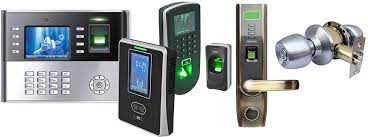Access control and Time attendance
Biometric access control systems
Biometric access control systems
Biometric access control systems are digital entry systems that control physical access to a building or room using biometrics technologies. Biometrics are unique physical characteristics that can be used to identify individuals, such as fingerprints, facial features, iris patterns, palm veins, and voice recognition.
Biometric access control system work by comparing a person’s unique biometric characteristics to a database of stored biometric templates about authorized users. If there is a match, the person is allowed in; otherwise, the person is denied access.
Biometric access control system offer a number of advantages over traditional access control system, such as key cards and PIN codes:
- Improved security: Biometric characteristics are very difficult to forge or counterfeit, making them a more reliable way to identify individuals.
- Convenience: Biometric access control systems are often hands-free and easy to use. Users do not need to carry or remember keys or codes.
- Auditability: Biometric access control systems can track who entered and exited a secure area at what time. This information can be used for security audits and to investigate suspicious activity.
Biometric access control solutions are used in a wide variety of applications, including:
- Commercial buildings
- Government facilities
- Educational institutions
- Healthcare facilities
- Data centers
- Military bases
- Airports
Biometric access control system are becoming increasingly popular as the technology continues to improve and become more affordable.
Here are some examples of biometric access control system:
- Fingerprint scanners: Fingerprint scanners are the most common type of biometric access control system. They work by reading the unique pattern of ridges and valleys on a person’s fingerprint.
- Facial recognition systems: Facial recognition systems identify individuals by analyzing their facial features. Facial recognition systems have become increasingly accurate in recent years, but they can be less reliable in certain conditions, such as low light or when people are wearing masks.
- Iris scanners: Iris scanners identify individuals by analyzing the unique patterns in their irises. Iris scanners are very accurate, but they are also more expensive than other types of biometric access control systems.
- Palm vein scanners: Palm vein scanners identify individuals by analyzing the patterns of veins in their palms. Palm vein scanners are becoming increasingly popular because they are accurate, affordable, and easy to use.
When choosing a biometric access control system, it is important to consider the following factors:
- Security requirements: The level of security required will determine the type of biometric access control system that is best suited for your needs. For example, a high-security environment may require a more expensive and sophisticated system, such as an iris scanner.
- Budget: Biometric access control systems can range in price from a few hundred dollars to several thousand dollars. It is important to set a budget before you start shopping.
- Ease of use: Biometric access control systems should be easy to use for both authorized users and security personnel.
- Scalability: If you plan to grow your business or organization in the future, you will need a biometric access control system that can scale to meet your needs.
It is also important to consult with a security professional to get their recommendations on the best biometric access control solution for your specific needs.

